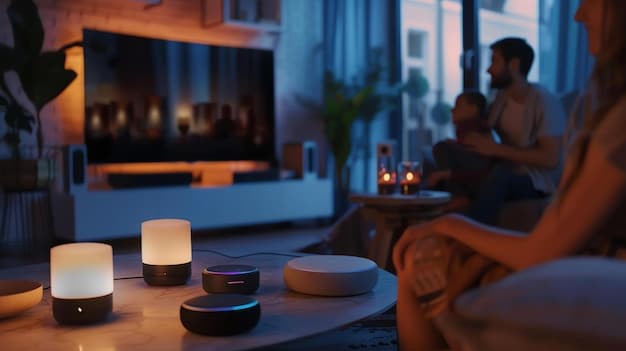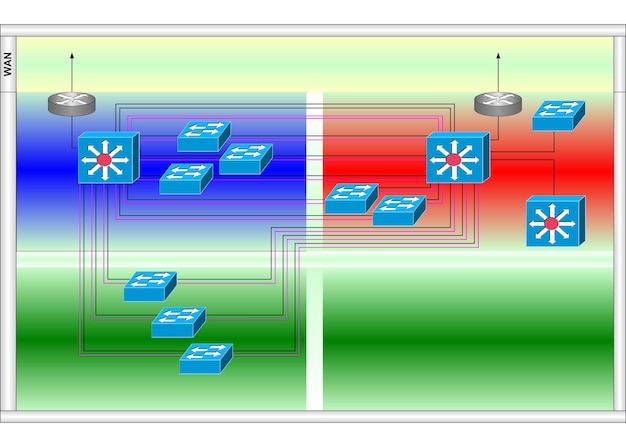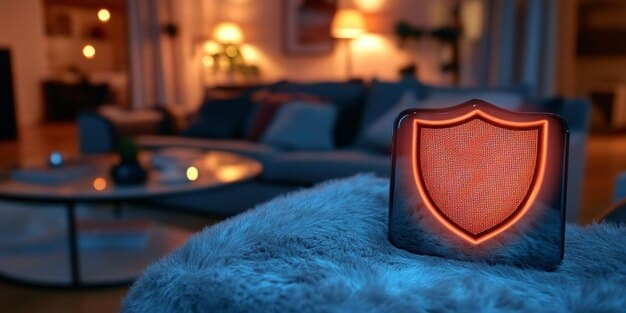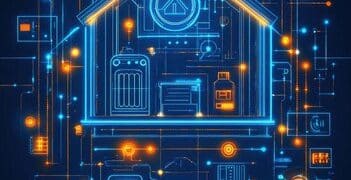Matter 2.0: Reshaping Smart Home Interoperability in 2025

Matter 2.0 protocol is poised to revolutionize smart home interoperability in 2025 by establishing a unified connectivity standard, enabling seamless communication between devices from different manufacturers, enhancing user experience, and fostering innovation in the smart home ecosystem.
The landscape of smart homes is constantly evolving, and 2025 promises to be a pivotal year for interoperability. How will the new Matter 2.0 protocol reshape smart home interoperability in 2025? This advancement is set to streamline device communication and user experience across various ecosystems.
Understanding the Current State of Smart Home Interoperability
Currently, smart home interoperability faces numerous challenges. Different manufacturers use various communication protocols, leading to fragmentation and creating obstacles for consumers who want to integrate devices from multiple brands. This lack of standardization often results in a frustrating user experience.
Challenges in Existing Smart Home Ecosystems
The smart home market is crowded with competing ecosystems, each vying for dominance. This competition has led to a lack of cooperation, with devices often being designed to work best (or only) within a specific ecosystem. This fragmentation makes it difficult for consumers to create a truly seamless smart home experience.
The Need for a Unified Standard
A unified standard is essential to overcome these challenges. By establishing a common language for smart home devices, interoperability can be significantly improved, allowing devices to communicate and work together regardless of their brand or ecosystem. This would simplify the user experience and promote innovation.
- Simplified setup and onboarding of new devices.
- Enhanced compatibility between different brands and ecosystems.
- Improved user experience with seamless device integration.
- Greater flexibility in choosing smart home devices.
Ultimately, the current state of smart home interoperability highlights the urgent need for a unified standard like Matter 2.0 to create a more cohesive and user-friendly experience for consumers.
What is Matter 2.0 and Its Key Features?
Matter 2.0 is a revolutionary protocol designed to create a more connected and interoperable smart home ecosystem. It aims to solve the fragmentation issues by providing a unified standard for devices to communicate, regardless of the manufacturer or platform.

Core Principles and Objectives of Matter 2.0
The core principles of Matter 2.0 revolve around simplicity, reliability, and security. Its primary objectives include: ensuring seamless interoperability between devices, simplifying the setup process for consumers, and enhancing the security of smart home networks. By adhering to these principles, Matter 2.0 seeks to create a more user-friendly and trustworthy smart home environment.
Technical Specifications and Improvements Over Previous Protocols
Matter 2.0 utilizes a combination of technologies, including Wi-Fi, Thread, and Bluetooth Low Energy, to ensure broad compatibility. It improves upon previous protocols by offering a more streamlined architecture, enhanced security features, and a standardized approach to device certification. These technical advancements make Matter 2.0 a robust and future-proof solution for smart home connectivity.
In essence, Matter 2.0 is poised to transform the smart home landscape by providing a universal standard that promotes interoperability, simplifies setup, and enhances security, ultimately benefiting both consumers and manufacturers.
How Will Matter 2.0 Enhance Smart Home Interoperability?
Matter 2.0 is poised to significantly enhance smart home interoperability by providing a universal language for devices to communicate. This standardization breaks down the walls between different ecosystems, allowing devices from various manufacturers to work together seamlessly.
Enabling Seamless Communication Between Devices
With Matter 2.0, setting up new devices becomes easier and more intuitive. The unified protocol simplifies the discovery and onboarding process, eliminating the need for multiple apps and complicated configurations. This streamlined experience makes it easier for consumers to integrate new devices into their smart home networks.
Simplifying Setup and Onboarding Processes
Matter 2.0 simplifies the setup process by providing a consistent onboarding experience across different devices and platforms. This means users can add new devices to their network with minimal effort.
- Simplified device discovery and connection.
- Reduced need for multiple apps and accounts.
- Standardized onboarding process across different ecosystems.
- Improved user experience with intuitive setup procedures.
Matter 2.0 promises to enhance smart home interoperability by enabling seamless communication between devices and simplifying the setup and onboarding processes. This unified standard will make it easier for consumers to create a truly connected and integrated smart home.
The Impact of Matter 2.0 on Different Smart Home Ecosystems
Matter 2.0’s introduction is set to have a profound impact on various smart home ecosystems, driving them toward greater interoperability and collaboration. This shift is expected to benefit both consumers and manufacturers, fostering a more unified and user-friendly smart home environment.
Apple HomeKit, Google Home, Amazon Alexa: A Comparative Analysis
Each major smart home ecosystem—Apple HomeKit, Google Home, and Amazon Alexa—stands to gain unique advantages from Matter 2.0. Apple HomeKit will benefit from enhanced device compatibility, while Google Home and Amazon Alexa will see improved user experience and broader device support. This comparative analysis highlights the potential for Matter 2.0 to level the playing field and promote innovation across these platforms.
How Matter 2.0 Encourages Collaboration Among Manufacturers
Matter 2.0 fosters collaboration among manufacturers by providing a common standard for device communication. This shared framework encourages companies to work together, creating a more cohesive and interoperable smart home ecosystem.
- Standardized device compatibility.
- Simplified development and certification processes.
- Reduced fragmentation in the smart home market.
- Greater opportunities for innovation and collaboration.
Matter 2.0 is poised to drive significant change in the smart home industry by promoting collaboration and interoperability across different ecosystems, ultimately benefiting consumers and manufacturers alike.
Addressing Potential Challenges and Concerns
While Matter 2.0 holds immense promise for enhancing smart home interoperability, it’s essential to address potential challenges and concerns that may arise during its implementation. These include security vulnerabilities, compatibility issues, and the need for ongoing updates and maintenance.

Security Considerations and Potential Vulnerabilities
Security is paramount in any interconnected system, and Matter 2.0 is no exception. Addressing potential vulnerabilities and ensuring robust security measures are crucial to maintaining user trust and protecting smart home networks from cyber threats. Thorough testing and ongoing monitoring are essential to mitigate these risks. Potential vulnerabilities include unauthorized access, data breaches, and device hijacking.
Ensuring Compatibility with Existing Devices
Ensuring compatibility with existing devices is another significant challenge. While Matter 2.0 aims to provide a unified standard, older devices may not be easily upgradable, leading to compatibility issues. Strategies for bridging the gap between legacy devices and Matter 2.0-enabled devices are essential to ensure a smooth transition. This can involve software updates, hardware adapters, or other innovative solutions.
Addressing these challenges proactively will be critical to realizing the full potential of Matter 2.0 and creating a secure, interoperable, and user-friendly smart home ecosystem.
The Future of Smart Homes: Predictions for 2025 and Beyond
Looking ahead to 2025 and beyond, the future of smart homes is inextricably linked to the success and adoption of Matter 2.0. As the protocol becomes more widespread, we can expect to see significant advancements in interoperability, security, and user experience, paving the way for a more seamless and integrated smart home environment.
Anticipated Trends and Innovations
Several key trends and innovations are expected to shape the future of smart homes. These include the rise of AI-powered devices, the integration of smart home technology into everyday appliances, and the development of more personalized and intuitive user interfaces. Matter 2.0 will play a crucial role in enabling these advancements by providing a unified platform for device communication and data sharing. As AI becomes more prevalent in smart homes, Matter 2.0 will facilitate seamless integration and enhanced functionality across different devices and ecosystems. The rise of edge computing will also contribute to the development of more responsive and intelligent smart homes.
The Role of Matter 2.0 in Shaping the Smart Home Landscape
Matter 2.0 is poised to play a pivotal role in shaping the smart home landscape by fostering greater interoperability and collaboration. This unified standard will drive innovation and create new opportunities for manufacturers to develop cutting-edge smart home solutions.
- Greater device interoperability.
- Improved security and privacy.
- Enhanced user experience.
- Increased adoption of smart home technology.
Matter 2.0 is expected to usher in a new era of smart home connectivity, transforming the way we interact with our homes and creating a more seamless and integrated living experience.
| Key Point | Brief Description |
|---|---|
| 💡 Unified Standard | Matter 2.0 creates a universal language for smart home devices. |
| 🔒 Enhanced Security | Improved security protocols protect smart home networks. |
| ⚙️ Simplified Setup | Easier onboarding process across different devices. |
| 🤝 Collaboration | Encourages manufacturers to work together. |
Frequently Asked Questions
▼
The primary goal of Matter 2.0 is to create a unified standard for smart home devices, enabling seamless interoperability between different brands and ecosystems.
▼
Matter 2.0 incorporates robust security protocols to protect smart home networks from cyber threats, ensuring data privacy and preventing unauthorized access.
▼
Matter 2.0 utilizes a combination of Wi-Fi, Thread, and Bluetooth Low Energy to ensure broad compatibility and reliable communication between devices.
▼
While Matter 2.0 aims for broad compatibility, some older devices may require updates or adapters to fully integrate with the new protocol.
▼
Matter 2.0 provides a streamlined onboarding process, eliminating the need for multiple apps and complicated configurations, making it easier to add new devices.
Conclusion
In summary, Matter 2.0 is set to revolutionize smart home interoperability by establishing a unified standard, enhancing security, and simplifying the user experience. The widespread adoption of Matter 2.0 promises a future where smart home devices work together seamlessly, creating a more connected and user-friendly living environment.





